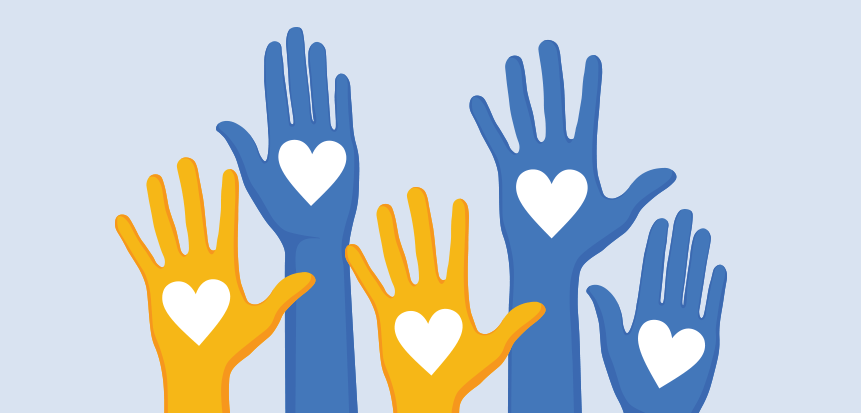
Click the button to start reading
10 Simple Ways to Start Practicing Gratitude
After the last 2 years, it’s understandable that people are struggling to practice gratitude or even find things to be grateful for. It seems like the world is on fire but there are ways to initiate the process of making space for gratitude.
For starters, you are reading this article on some kind of smart device with a decent internet connection, likely sheltered from the elements, and with food in your belly. Given that 40% of the world’s population is still offline, 1.6 billion people lack adequate housing, and one in four people are food insecure, it seems kind of silly to not feel at least somewhat grateful… doesn’t it?
The ability to be grateful is powerful and will have a ripple effect across all aspects of your life, professional and personal.
If practicing gratitude was easy, everyone would be doing it. In order to be successful in this venture, you will need to understand the barriers that tend to stop people in their tracks.

Barriers to Gratitude
Even if you acknowledge that you have quite a bit to be grateful for at this present moment, gratitude doesn’t always come naturally… on the contrary actually. Gratitude goes against our human nature because our brains are hardwired to give more weight to negative experiences.
This is called negativity bias.
The psychology behind this phenomenon is why we place so much pressure on making a good first impression because we know that bad impressions stay with us longer. If you find yourself still thinking of the kid in middle school who picked his nose as… well… the kid from middle school who picked his nose even though he is now a successful pilot, you are experiencing the negativity bias.
What this also means is that we tend to learn more effectively from our bad experiences instead of positive ones because the bad ones stick out in our mind. We tend to remember the consequence more than we remember the reward and this is called loss aversion. We’re much more likely to perform a task if we’ll lose something from not doing it as opposed to gaining something from doing it.
We have all heard the saying that comparison is the thief of joy, it also steals our ability to be grateful for what we have. This saying has never been more true in a time that makes it easier than ever to see what others are up to. In our pockets, we have 24/7 access to everyone we have ever known and their life highlights grace our news feeds multiple times a day.
We see that Jennifer bought a new car, Jason is skidooing at his summer home, and the Jones’s just welcomed their third child in a beautiful and professionally photographed home birth.
While these things could all be true and certainly make for great social media content, we may not see that Jennifer is drowning in debt, Jason is battling depression, and the Jones’s had experienced 3 miscarriages prior to this healthy birth. What people post online rarely tells the full story but we still find ourselves in a comparison competition that no one can win because no one is competing in the same arena.
It is important to understand that people are (generally) only sharing their highlights. Because of this, we form unrealistic expectations of our own lives and strive to compete with the unattainable standards of what we think other people are doing and achieving on a regular basis. This additional pressure leads to unrealistic goals set by people who don’t even know our priorities or passions. Always being told to hustle for future goals that are not even yours makes it significantly harder to live in the present and be grateful for what you have.
Professionally, you may follow CEOs or other successful business people and be in awe of their status and accomplishments. What you don’t see is all the hard work and failure they experienced along their journey to get to where you see them, you are only ever getting a small part of the whole story.
This additional exposure to other people’s perceived success has real implications in our everyday lives. You don’t have to look very far to find studies that show that less social media time directly correlates to increased happiness.
All of this to say, people who wish to make more space for gratitude are fighting an uphill battle against human psychology and the nature of social media… but that doesn’t mean that it’s impossible!

Health Benefits of Gratitude
Before we dig into some actual ways to practice gratitude, it is important to understand the health benefits that may help motivate ourselves into action.
Gratitude is an incredibly powerful human emotion, the physical responses of which have been measured and studied extensively. It affects the brain in a number of positive ways that manifest in real mental and physical responses including:
- Pain Reduction: A study by Emmons & McCullough in 2003 found that patients who kept gratitude journals saw an impressive 16% reduction in their pain! This is an incredible finding and, looking deeper, we understand this to be because gratitude allows for better regulation of dopamine (the happy chemical) in our brains which helps us better deal with pain and heal.
- Sleep Quality: Keep that gratitude journal on your nightstand and you just may find that you sleep better. Taking a moment to jot down a couple of things you were grateful for in your day will set the tone for your night but also helps to activate your hypothalamus (the part of your brain that regulates a number of body functions) to better regulate your sleep.
- Better Mood: It doesn’t take a rocket scientist (or brain surgeon) to conclude that practising being grateful will put you in a good mood. The parts of the brain responsible for emotions are activated when we feel gratitude which causes us to feel good.
- Reduction in Stress and Anxiety: Cortisol, the stress hormone, is greatly reduced when someone practices gratitude. That isn’t to say that you will never feel stress or anxiety if you are grateful but what it does do is allow people to better respond to stressful situations and manage negative experiences.
- Changes Brain Structure: The Mindfulness Awareness Research Center has some pretty impressive research on the physical changes that happen in your brain when you practice or are on the receiving end of gratitude. Neurochemicals in the brain that catalyze your feel good neurotransmitters are more responsive and the result is that you feel happier.
10 Ways to Start Practicing Gratitude Today
1. Start a Gratitude Journal
Do not dismiss gratitude journals as childish or fluffy, there is power in words and they are even stronger when you write them down. Gratitude journals are tried and true, and the easiest way to start practising gratitude immediately. Physical or digital, plain notepad or bedazzled journal, the goal is simply to start somewhere. Some people like to start with writing 3 things down in point form, and some people prefer to doodle and really elaborate their thoughts. Even a couple of sentences at the bottom of your planner counts!
2. Get an Accountability Buddy
Find someone who would also like to get some practice expressing and receiving gratitude and form an alliance. It is helpful if this is someone that you interact with regularly so that you can practice with them. Think of everyday interactions that could involve gratitude, like feedback on presentations or reports. Take a moment to express gratitude for their work and be as specific as possible.
3. Write Thank You Notes
Never underestimate the power of a handwritten note. While an email or a text is a great way to send a quick message, take a moment once a week to write a short note expressing gratitude and mail (snail mail) or hand deliver this message. If you have a team of 4 people and write a note once a week, each person will be on the receiving end of your gratitude at least once a month! Buy a pack of generic thank you cards or even a lined notepad and keep it handy for when inspiration strikes.

4. Take In Good News Stories
Everywhere we look, we see bad news: natural disasters, crime, environmental injustice… it’s draining. While it is important to be informed and not ignore important information, bad news 24/7 is not good for our mental health and certainly doesn’t help people practice gratitude. Unfortunately, mainstream media tends to focus on bad news and the feel good stories seem to be few and far between. Do yourself a favour and take initiative to seek out some good news for once, check out sites like Good News Network that curate positive and inspiring content that won’t drain every ounce of happiness from your body.
5. Give and Receive Compliments
I bet you can remember a specific moment in time that someone went out of their way to give you a compliment. Maybe the lady on the bus loved your jacket, or someone swooned over your handwriting, or you nailed a presentation and someone pulled you aside to congratulate you… it felt good right? It also feels great to be the one giving the compliments. Don’t be quiet, speak up if you see something you like and you could very well make someone’s day.
6. Keep a Positive Feedback File
This can be a physical or digital digital space, you only need to be able to save documents or open a drawer to add to it. Having a place where you can store thank you cards or nice emails will make it easy to go back and reference them when you need a boost. It’s also helpful to remind yourself that there are people in your circle who are grateful for you. While you are working on making space for gratitude, remember that there are other people who are trying to do the same. Being reminded that your note or email or feedback stayed with someone enough that they chose to save it to review is pretty special and will help motivate you to do the same.
7. Surround Yourself with Quotes and Images that Inspire You
Your mind probably went straight to the inspirational posters with the black border that can be found in every single classroom across the country. As corny as it wounds, sometimes, a pithy saying by an influential person is just what we need to hear and there is science to back that up. Motivational expert Jonathan Fader likens inspiration quotes to self coaching. It is known that you are likely to perform better when someone believes in you so unless you have access to an actual coach, a great quote from someone who inspires you will work surprisingly well. Humans are wired to look to the people around us for inspiration, we tend to trust people who have achieved some sort of success and their words resonate with us.
8. Say Thank You
When we talk about gratitude, the words “thank you” are usually the first thing that comes to mind. Just because it seems simple, doesn’t mean that it isn’t important. While we are often quick to thank the person serving us coffee or holding open a door, it takes more practice to thank people for less overt actions. Consider a time that someone gave you a compliment, was your first instinct to brush it off or did you reply with a “thank you”? Too often, the notion of being humble takes over but saying thank you takes practice, practice it every day.
9. Practice Mindfulness
For some reason, people tend to check out when they hear the word “mindfulness”. This may be because they have this image in their mind of someone sitting on a pillow, legs crossed, hands resting on their knees and breathing in the smell of diffused essential oils. While that can absolutely be true, the act of being mindful looks different for each person. In essence, mindfulness is simply being fully present where we are. Start small by recognizing the feeling of the clothes on your skin or the smell of the air. Pausing and taking a deep breath before engaging in a task is also a form of mindfulness and is a great place to start. There are great resources available online for more tips and you can even check out How Can Mindfulness Improve Your Time Management.

10. Volunteer
After a gratitude journal, volunteering is one of the most tangible and effective ways to practice gratitude and give back at the same time. Volgistics lists a number of health benefits of volunteering, most notably:
- Connection with others and your community: connecting not just with other volunteers but the people that you may be serving is a great way to build your network and practice gratitude.
- Contribution outside of yourself: what better way to express gratitude than to give your time and energy to a worthy cause? Whether it is serving food at a shelter or walking dogs, contribution increases your sense of worth, belonging, and increases self confidence.
- Encourages development: chances are that you will need to learn a thing or two when you first start volunteering: brushing up on cooking skills, speaking in a second language, or even your handy work.
- Increased in overall physical wellbeing: getting out of the house and moving your body is a great start. Maybe your volunteer commitment isn’t very physical but every little bit helps. We know that volunteering reduces stress and stress is directly correlated to heart health. Volunteering is good for your heart!
Volunteering one hour a week is a great place to start. You may just find yourself offering more time as you reap the benefits of engaging with a cause and give back at the same time.

Gratitude in the Workplace
It is obvious that practising gratitude has some serious health benefits but it can also foster a healthier work environment. Check out the blog Want a Healthier Workplace? Begin With Gratitude for all the details but, in summary, gratitude can transform an organization and its culture by:
- Increasing job satisfaction
- Encouraging employees to feel motivated, engaged, and productive
- Drives greater organizational innovation and performance
Gratitude is foundational to everything you do. Start with implementing just one of the 10 tips listed above and you will see improvements in both your personal and professional welling.
















